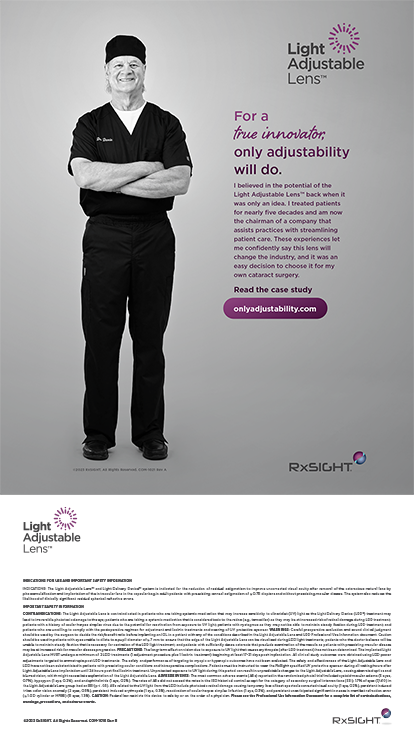The Avantix endocapsular vortex emulsification technology (Bausch & Lomb, San Dimas, CA), introduced by Richard Kratz, MD, was originally introduced under the name Catarex. It uses a rotary impeller to create an endocapsular vortex that emulsifies lens fragments without using ultrasound or a laser. The technology offers a different approach to small-incision cataract surgery, and carries a number of potential advantages over ultrasonic phacoemulsification, such as a lack of any significant heat buildup, making wound burn virtually impossible. Another advantage that Avantix offers is that of a true endocapsular procedure, which is enhanced by the use of a stationary probe. The problem with other attempted endocapsular techniques is that it is difficult to maneuver the other probes through one small incision. However, the Avantix system minimizes the need for excessive maneuvering. The surgeon makes a small, peripheral, 1-mm capsulorhexis, inserts the probe, and then holds the probe relatively stationary throughout the rest of the procedure while the impeller and the vortex technology do most of the work. Among the various phacoemulsification procedures currently available, I think Avantix is the best suited for true endocapsular surgery through a microincisional capsulorhexis.
HOW IT WORKS
The impeller, when inserted into the capsular bag through its tight-fitting 1-mm capsulorhexis, serves two functions. First, it creates a vortex in the bag that destabilizes the lens, mobilizes the lens, and creates a current that brings fluid to the impeller. The apparatus supplies both inner flow to the capsule, which supplies pressurization that keeps the bag inflated, as well as replacement fluid for that which is aspirated through the center of the impeller shaft, including the emulsified particles (Figures 1 and 2). Second, in addition to creating this vortex or endocapsular current, the impeller also serves the function of physically emulsifying the lens material when it comes into direct contact with it. Therefore, the two functions of the impeller are synergistic in that they bring material to the tip, and at the same time emulsify that material. Now, the current that is created inside of the eye, the endocapsular vortex, also serves to keep the capsular bag inflated through the centrifugal force of the rotating current. This force, along with the positive pressure from the irrigation ports, maintains the endocapsular space to enhance the safety and efficacy of the procedure.
The control parameters of the Avantix technology are basically a variation of the impeller rotational speed along with very slight rotational movements of the probe housing. However, the machine parameters have a much narrower range than traditional phacoemulsification equipment, specifically in regard to fluidics.
AVANTIX VS. ULTRASOUND TECHNOLOGIES
WhiteStar Technology (Allergan, Inc., Irvine, CA) is based on traditional ultrasound. In fact, one of its cited advantages is its ability to accommodate traditional ultrasound techniques, such as sculpting, divide-and-conquer, and chopping. Another potential advantage of WhiteStar is that it may offer a decreased propensity toward incisional wound burns by varying the duty cycles of its burst mode. By staggering its On/Off cycles, the technology is thought to give the tissue more time to thermally recover from any friction generated by the On cycle of the ultrasound pulse. However, although decreasing the incidence of wound burn is a benefit, WhiteStar carries the same disadvantage as any other ultrasonic modality in regard to performing endocapsular surgery. For a surgeon to perform ultrasound through a 1-mm opening, he or she must maneuver the tip quite a bit, and many surgeons are accustomed to using a second instrument for bimanual techniques such as divide-and-conquer and chopping, which would be rather difficult with a single, 1-mm capsulorhexis opening in an intracapsular fashion. With Avantix, surgeons are able to perform the surgery through a microincision; they simply hold the probe relatively stationary while the vortex effect brings the material to the aspiration tip. Surgeons do not need another instrument, and they do not need to maneuver the probe significantly, as in traditional ultrasound.
FUTURE POTENTIAL
I believe the Avantix system has tremendous promise given its advantages for an intracapsular procedure. One of the most exciting potential applications for the technology is in conjunction with a truly injectable, physiologic lens implant—an injectable gel that surgeons could insert through the 1-mm capsulorhexis opening and that would become a functioning crystalline lens. This gel would accommodate within the eye, and essentially restore the lens that the patient had when he or she was a teenager. This would most physiologically be achieved through an intracapsular surgery.
There is only a slight modification in the surgical technique for Avantix for implanting an injectable crystalline lens. Remember that at the conclusion of surgery with current lens technology, the surgeon must inject viscoelastic inside the capsular bag and then open up the capsulorhexis. To insert an injectable lens implant, he or she would not widen the off-center capsulorhexis, but would instead leave it as a 1-mm opening. Then, rather than injecting viscoelastic into the clear anterior capsule, the surgeon would inject an optical gel that could be catalyzed to firm up slightly, but still retain its elastic properties, and essentially function as a true physiologic replacement lens.
Avantix appears to be a very promising new technology. I am looking forward to the clinical trials as they unfold, because they are ultimately the true test of any new technology, and I believe that our clinical information will grow tremendously within this year.Barry S. Seibel, MD, is Director of Cataract Surgery at the Maloney-Seibel Vision Institute in Los Angeles, California. Dr. Seibel also serves as Clinical Assistant Professor of Ophthalmology at the UCLA Medical School. He is a paid consultant for Bausch & Lomb, but has no direct financial interest in the technology discussed. Dr. Seibel may be reached at (310) 208-3937; drseibel@maloneyseibelvision.com. All illustrations by Barry Seibel, MD, ©2002.
For a description of Dr. Seibel's technique using the Avantix technology, please turn to page 40.


